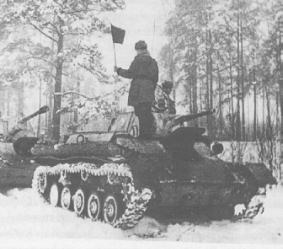
|
| Victory Points |
Armour | Start | Start | End | End | ||
| Front | Side | Rear | Month | Year | Month | Year | |
| 4 | 6 | 3 | 3 | 5 | 42 | 5 | 44 |
| T-70 Light Tank | ||||||||||||||||||||
| RANGE | 1 | 2 | 3 | 4 | 5 | 6 | 7 | 8 | 9 | 10 | 11 | 12 | 13 | 14 | 15 | 16 | 17 | 18 | 19 | 20 |
| HARD | 7 | 4 | 2 | . | . | . | . | . | . | . | . | . | . | . | . | . | . | . | . | . |
| SOFT | 5 | 4 | 3 | 2 | 1 | . | . | . | . | . | . | . | . | . | . | . | . | . | . | . |

|
T-70 Light Tank
|
Specification |
|
Although the T-70 Light Tank which was first rolled out in January 1942 was based on the chassis of the earlier T-60 it was actually a major redesign.The single engine of the T-60 was changed to two GAZ truck engines with the transmission driving the front drive wheels.The T-60 suspension was strengthened to accommodate the extra weight of armour and the turret which now housed a 45 mm (1.78 in) anti-tank gun.From March 1942 to October 1943 some 8,226 T-70s were manufactured and the T-70 served until the end of the war A sound but unexceptional reconnaissance vehicle its combat value was limited because the commander had to operate the gau as well as command the vehicle.The T-70A had extra amour and slightly up-rated engines but those did little to alter the overall performance.After 1943 production switched from T-70 light tanks to adapting the same chassis for the SU-76 assault gun but when the war ended many T-70s were still in service.Captured T-70s were pressed into service by the Germans and their allies.With their turrets removed they were employed as anti-tank or light field gun tractors. |